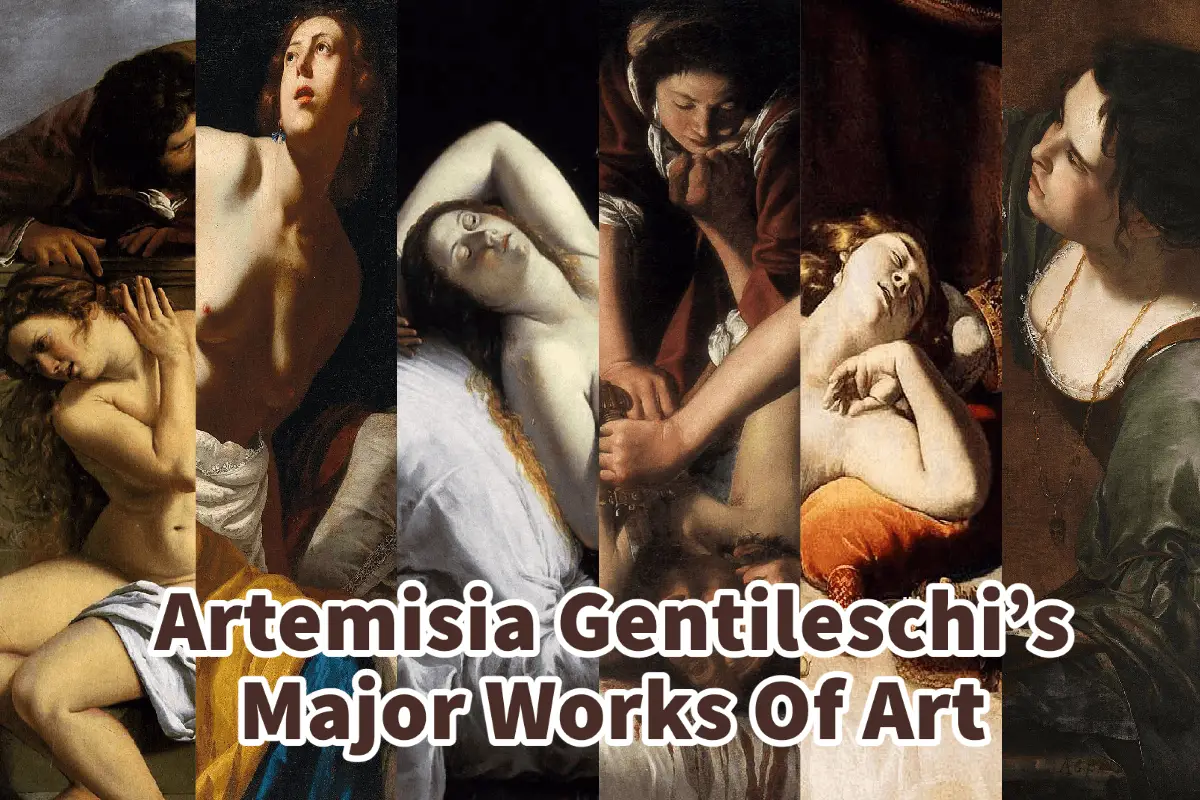Artemisia Gentileschi was a crucial Italian artist who lived from the late 16th Century to the mid-17th Century. She is known as a woman who broke many gender barriers in her art.
Artemisia Gentileschi painted many significant works of art as a full-time artist during her lifetime. She was an extremely gifted artist who gave a unique perspective on her painting subject. Many of her works of art have hidden messages about the repression of women by men.
Table of Contents
- The Pivotal Artworks of Artemisia Gentileschi
- Susanna And The Elders By Artemisia Gentileschi (1610)
- Danae By Artemisia Gentileschi (1612)
- Judith Slaying Holofernes By Artemisia Gentileschi (1620)
- Lucretia By Artemisia Gentileschi (1623-25)
- Cleopatra By Artemisia Gentileschi (1633-1635)
- Self-Portrait As The Allegory Of Painting By Artemisia Gentileschi (1638, 1639)
- Frequently Asked Questions
- Related Questions
The Pivotal Artworks of Artemisia Gentileschi
IArtemisia Gentileschi, a trailblazing Italian artist of the late 16th and mid-17th centuries, is celebrated for shattering gender norms in the art world. As a prolific and full-time artist,
Gentileschi created numerous significant works that showcased her exceptional talent and offered a unique perspective on the subjects she painted. Her art often carried profound underlying messages about the oppression of women, making her pieces visually compelling and rich in social commentary.
Here are some of the most important and significant works of art by Artemisia Gentileschi
Susanna And The Elders By Artemisia Gentileschi (1610)
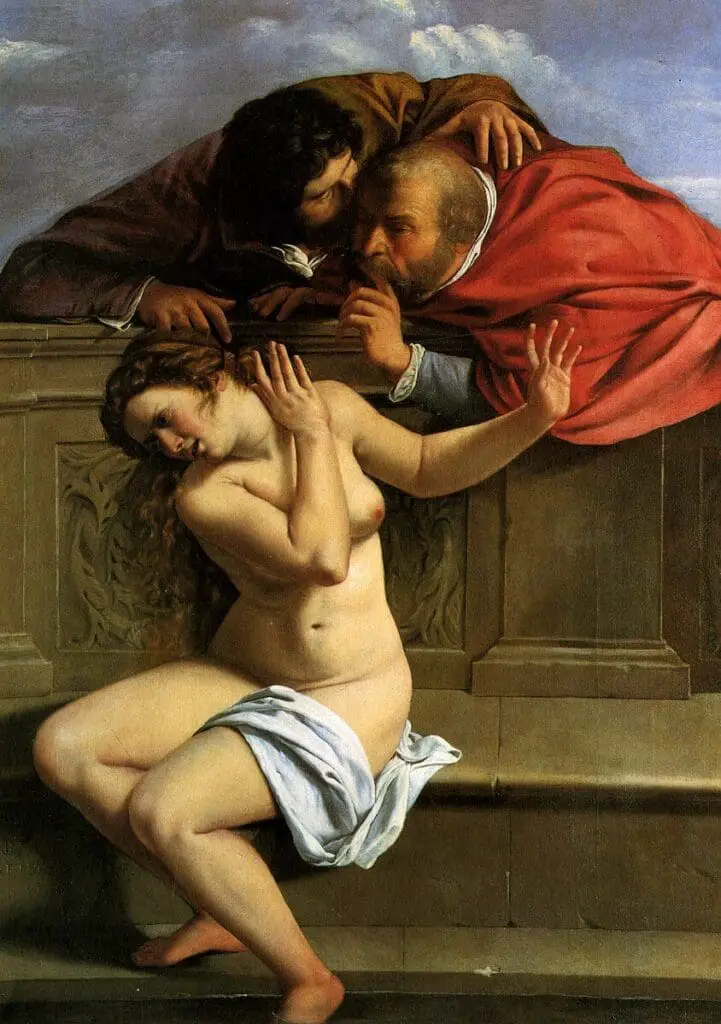
Susanna and the Elders is the first work known to have been painted entirely by Artemisia Gentileschi. At the time of the painting, she was only 17 years old.
Susanna and the Elders show a frequently depicted biblical scene of two voyeuristic elders spying on the virtuous Susanna while bathing. The elders then try to blackmail Susannainto, having sexual relations with them.
What is unique about this painting is that Artemisia Gentileschi shows Susanna and the stress of being watched by these men; Susanna was clearly in distress of not wanting to have sexual relations with these men.
Artemisia Gentileschi’s showing of Susanna in distress is very different from how many of the other artists painted the same subject matter; many of those artists showed Susanna wanting to have attention.
Artemisia Gentileschi painted this painting before her rape with Tassi; we do not know if she had other unwelcome encounters or sexual attention before she suffered her rape with Tassi. Painting Susanna as somebody who did not want to have the attention of these men and instead was a frightened young girl was very much a woman’s perspective on this event.
Danae By Artemisia Gentileschi (1612)

The painting of Artemisia Gentileschi called Danae depicts the Greek mythology of Danae. In the Greek Methodology, the daughter of Acrisius, the King of Agros, is foretold through an oracle that Danae will have a son who will kill her father, Acrisius.
Her father believes in this oracle and imprisons her in an attempt to prevent her from getting pregnant. The Greek God Zeus visits Danae in the form of a shower of gold, and she gets pregnant and conceives Perseus, who accidentally kills her father, Acrisius, or King of Agros.
Artemisia Gentileschi’s painting of Danae depicts Danae just as she becomes impregnated with a shower of gold.
Danae was also an additional subject for paintings depicted by other artists during this period. Usually, that artist would represent Danae as either very promiscuous or greedy because she wanted to accept the gold shower greedily.
Artemisia Gentileschi’s Danae is neither aggressive nor innocently aware of what is happening. Instead, she is shown in the process of experiencing the consumption that is taking place.
Some art historians believe that Artemisia Gentileschi showed the sexually aroused Danae, but others argue that Artemisia Gentileschi is depicting sexual violence forced on her.
Since Artemisia Gentileschi experienced a violent rape, I believe she depicted sexual violence and not sexual pleasure.
In the background, you can see that the servant is there, ignoring what is happening and greedily collecting the gold coming down. This could also be about Artemisia Gentileschi’s so-called friend Tuzia who knew of her rape but did nothing to help Artemisia.
Judith Slaying Holofernes By Artemisia Gentileschi (1620)
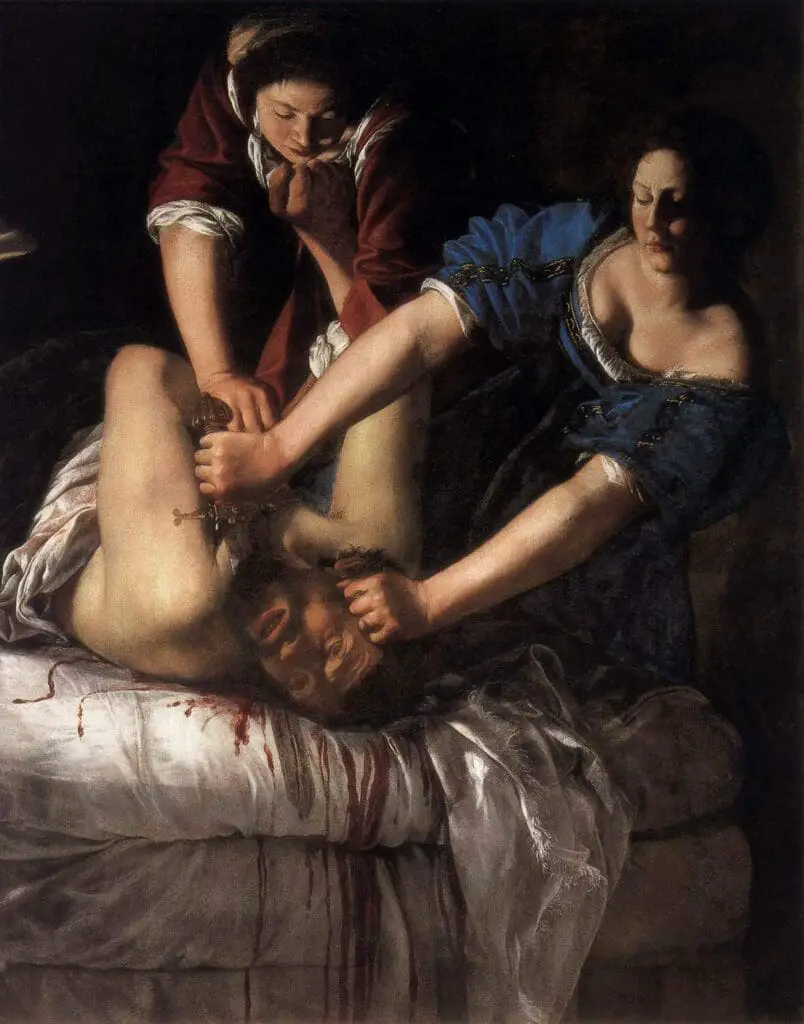
In Judith with the slaying of Holofernes, Artemisia Gentileschi is once again returning to a biblical story of Judith beheading Holofernes. Many other artists also painted this scene, but for many, they focused on the beauty and courage of Judith rather than the violent act.
In this painting, Artemisia Gentileschi shows us the moment that the beheading is taking place, and Holofernes is being beheaded. She also shows how the women struggled with Holofernes, one woman helping to hold him down while Judith beheads him.
Artemisia Gentileschi is showing us the power of women. Many other artists’ paintings show Judith as a servant or a weaker woman. But this painting by Artemisia Gentileschi shows Judith as a strong young woman actively participating in Holofernes’s beheading.
Many felt that Artemisia Gentileschi had painted herself as Judith in this painting. Maybe it was in rebellion to the abuse she thought she had suffered under men, particularly her rape and the public humiliation and trial that happened afterward.
Lucretia By Artemisia Gentileschi (1623-25)
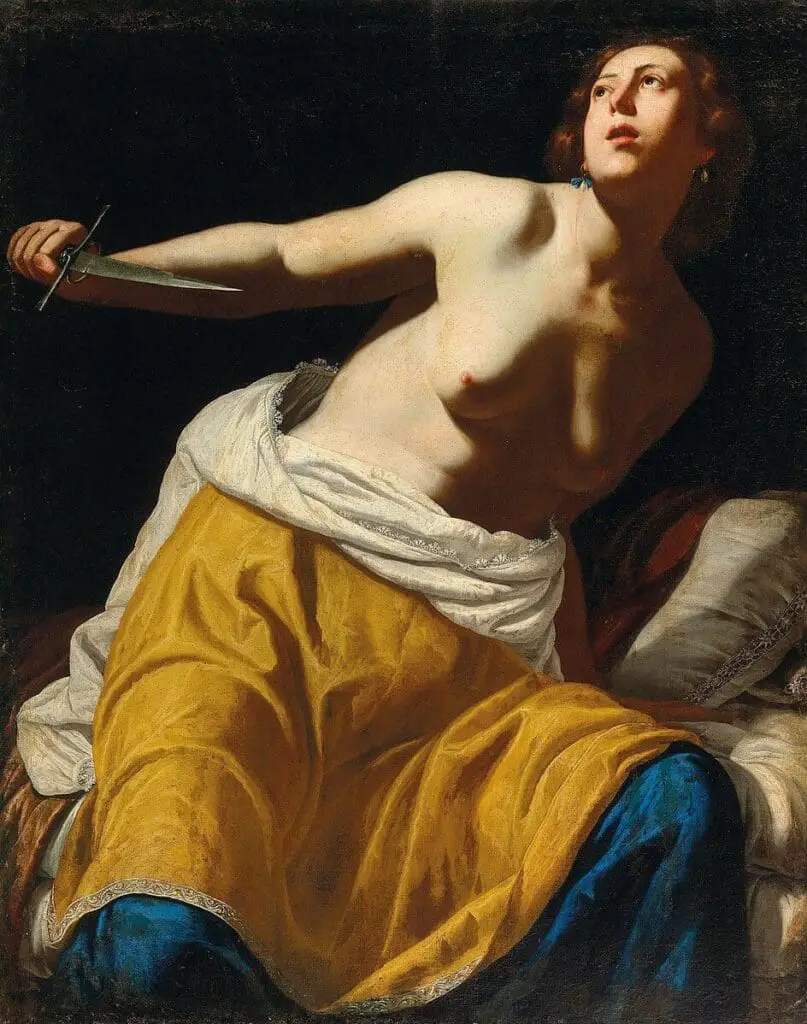
In her painting Lucretia, Artemisia Gentileschi returns to painting some classical mythology. Lucretia was raped, and after confessing what happened to her, she decided to kill herself.
Lucretia became a famous classical symbol against the tyranny of men. Lucretia was also a symbol of female defiance against men.
In this painting of Lucretia, Artemisia Gentileschi paints the exact moment when Lucretia decides to stab herself. In this painting, Lucretia has no jewelry or anything to show her status or wealth but only has a disheveled robe.
Artemisia Gentileschi also shows us that Lucretia, even though living in a world where men mistreated her, still had her agency in the decision to end her own life. In a sense, Lucretia is a kind of female hero who used the choices she had before her to do what she felt needed to be done.
Cleopatra By Artemisia Gentileschi (1633-1635)
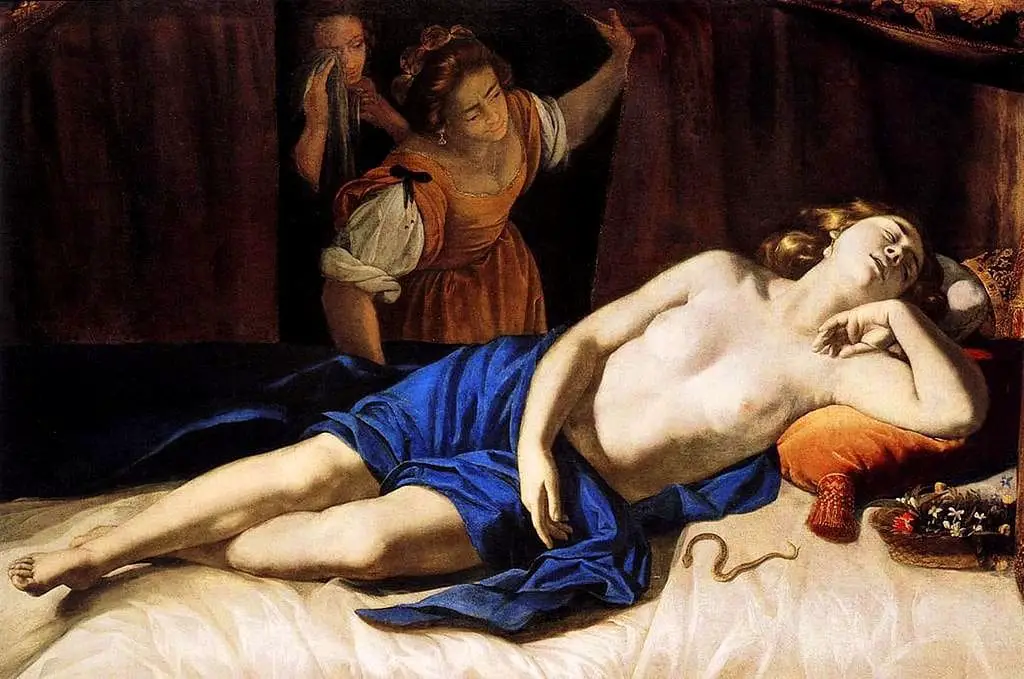
In this painting, Cleopatra, Artemisia Gentileschi shows another female who chose suicide due to being sexually exoticized by her male counterparts. Artemisia Gentileschi shows when Cleopatra is found dead by her female servants.
Cleopatra’s body seems to have some rigor mortis set in, which shows that she had been there for a while before she was found. Artemisia Gentileschi offers a complex vision of female power.
Cleopatra dies a lonely death after being driven to suicide due to men’s misuse. She shows that Cleopatra still had the agency to decide to take her own life.
The painting also symbolizes the world and time that Artemisia Gentileschi lived where women had very few choices, and the impact that those lack of options had on the women.
Self-Portrait As The Allegory Of Painting By Artemisia Gentileschi (1638, 1639)

In one of her last paintings, Artemisia Gentileschi uses herself as the subject matter for the painting. She shows herself as a painter with her palette and quick brushstrokes.
The brown background symbolizes a black canvas or her unfinished work as an artist. The painting depicts a rare female scene when women rarely had any jobs, let alone a well-known artist with commissions to paint.
Many have seen this painting of her statement that women could be artists and be successful.
Artemisia Gentileschi is considered one of the greatest artists of all time. She was also a trailblazer who showed that women could be artists. As a woman living in the 16th and 17th Centuries, artists everywhere owe it to Artemisia Gentileschi for courageously blazing the way.
Frequently Asked Questions
What are some of Artemisia Gentileschi’s most famous paintings?
Artemisia Gentileschi created several notable works of art during her career. Some of her most famous paintings include “Judith Slaying Holofernes,” “Susanna and the Elders,” and “Self-Portrait as the Allegory of Painting.”
How did Artemisia Gentileschi’s personal experiences influence her art?
Artemisia Gentileschi’s art often reflected her personal experiences, including instances of violence and the challenges she faced as a woman in the male-dominated art world. Her works, such as “Judith Slaying Holofernes,” are thought to convey themes of female empowerment and resistance.
What is the significance of “Judith Slaying Holofernes” in Artemisia’s body of work?
“Judith Slaying Holofernes” is considered one of Artemisia’s masterpieces. It depicts the biblical heroine Judith beheading the Assyrian general Holofernes. The painting is often interpreted as a powerful metaphor for female strength and the triumph of women over oppressive forces.
How did Artemisia Gentileschi challenge gender norms in the art world of her time?
Artemisia Gentileschi faced significant gender-based challenges in the 17th century, but she defied societal norms by pursuing a career as a professional artist. She gained recognition for her talent and became the first woman to be admitted to the Accademia delle Arti del Disegno in Florence.
What themes regarding the repression of women can be found in Artemisia’s art?
Artemisia Gentileschi’s art often explores themes related to the repression of women, depicting strong female characters resisting male dominance. Her paintings, like “Susanna and the Elders,” address issues of harassment and the vulnerability of women in a patriarchal society.
Did Artemisia Gentileschi use her self-portraits to convey specific messages?
Yes, Artemisia often used self-portraits to convey important messages. Her “Self-Portrait as the Allegory of Painting” is particularly significant, as it challenges the traditional notion of women as muses and highlights the importance of female artists in the creation of art.
How did Artemisia’s style differ from other artists of her time?
Artemisia Gentileschi’s style was characterized by a dramatic use of light and shadow, intense emotions, and a focus on strong, dynamic female figures. Her unique approach set her apart from many of her male contemporaries and contributed to her lasting legacy as an artist.
Were there controversies surrounding Artemisia’s work during her lifetime?
Yes, Artemisia Gentileschi faced both personal and professional controversies during her lifetime. Her rape trial, where she accused fellow artist Agostino Tassi, garnered attention and influenced the perception of her art. However, she persevered and continued to create impactful works.
What is the significance of Artemisia Gentileschi’s inclusion of female protagonists in her paintings?
Artemisia’s inclusion of strong female protagonists in her paintings challenged traditional gender roles and emphasized the agency and strength of women. This choice contributed to the development of a feminist interpretation of her work and solidified her reputation as a pioneering female artist.
How has Artemisia Gentileschi’s legacy evolved over time?
Initially overshadowed by male artists of her time, Artemisia Gentileschi’s legacy has grown significantly in the modern era. She is now celebrated as a trailblazer for women in art, and her works are recognized for their feminist themes and contribution to the evolution of Baroque painting.
Anita Louise Art is dedicated to art education, great artists, and inspiring others to find and create their art. We love art that uplifts and inspires. #ArtToMakeYouSmile! #ArtToMakeYouHappy!
If you want to see any of my art, you can find out more by clicking here. If you are interested in what inspires me and my paintings, you can discover more by clicking here.
We have a free newsletter and would love you to be part of our community; you can subscribe to the newsletter by clicking here. If you have any questions, I would be happy to talk to you anytime. You can reach me, Anita, by clicking here.
Subscribe to our Anita Louise Art YouTube Channel with great videos and information by clicking here.
Join us for our podcast “5 Minutes With Art.” just 5 minutes a week with us to discover and learn about great art and artists. You can find out more about our podcast by clicking here.
Related Questions
Is Art A Natural Gift, Or Can Anyone Be Good At Art If They Practice?
Most artists have some natural gift or desire to be an artist. But it is through their education, hard work, practice, and association with other artists that make all the difference. Having a natural gift is the start to becoming an artist, but just having a natural gift will not make you a good artist. Becoming a great artist requires practice, education, and a lot of hard work.
By clicking here, you can learn more by reading Is Art An Natural Gift, Or Can Anyone Be Good At Art If They Practice?.
Artemisia Gentileschi And Breaking Gender Barriers In Art
In the 17th Century in Italy, women had two career choices: joining a convent and becoming a nun or wife and mother. The laws also dictated that the man in the women’s lives, such as their fathers, husbands, and even sons, would make all the decisions for their lives. Women during this time had very few rights.
By clicking here, you can learn more by reading Artemisia Gentileschi And Breaking Gender Barriers In Art.

